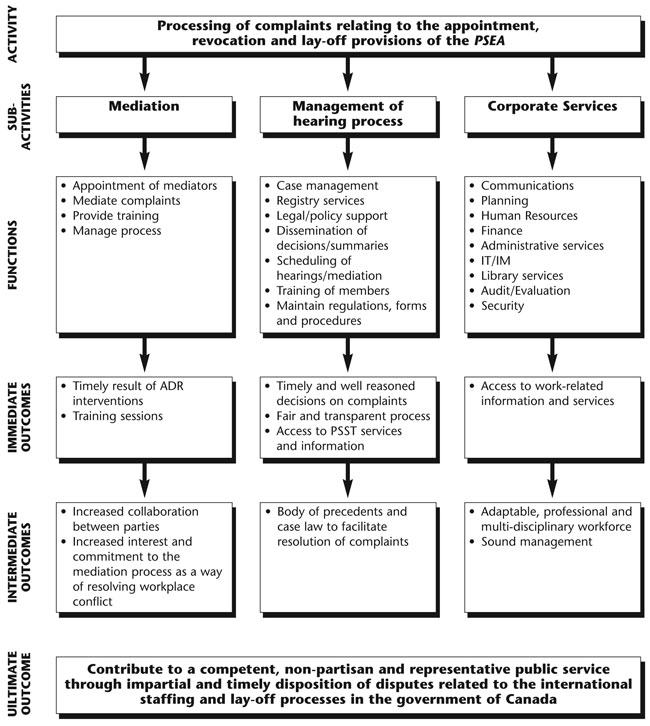Common menu bar links
Breadcrumb Trail
ARCHIVED - RPP 2007-2008
Public Service Staffing Tribunal
 This page has been archived.
This page has been archived.
Archived Content
Information identified as archived on the Web is for reference, research or recordkeeping purposes. It has not been altered or updated after the date of archiving. Web pages that are archived on the Web are not subject to the Government of Canada Web Standards. As per the Communications Policy of the Government of Canada, you can request alternate formats on the "Contact Us" page.
Analysis of Program Activities by Strategic Outcome
The PSST has a single strategic outcome: Contribute to a competent, non-partisan and representative public service through impartial and timely disposition of disputes related to the internal staffing and lay-off processes in the government of Canada. Accordingly, the PSST has one main activity – the processing of complaints relating to the appointment, revocation and lay-off provisions of the PSEA – and three sub-activities – the management of hearing processes, mediation and corporate services. The following chart depicts the links between the PSST's main activity and three sub-activities and their expected results for Canadians.


Performance Measurement
The PSST has established performance indicators and targets based on desired outcomes as part of its current performance measurement framework. These indicators and targets will need to be further developed and refined over time. A brief description of both indicators and targets follows:
PSST decisions are sound and well reasoned
This result is the ongoing primary concern of the PSST. Key performance objectives include:
- High quality of decisions. The PSST must issue sound decisions that provide effective recourse, withstand judicial review and are of high quality. An important measure of quality will be the number of legal challenges submitted to the Federal Court and, of those, the number dismissed.
- Fair and transparent process. The PSST must ensure that all parties are treated fairly, that all processes are fair and transparent and that it maintains its impartiality and independence. This indicator will be monitored by the number of challenges to the Federal Court, as well as through stakeholder feedback.
Compplaints are processed in a timely manner
A key challenge for the PSST will be to minimize the length of time to render decisions. Key performance indicators include:
- Stakeholder satisfaction. The PSST intends to conduct client satisfaction surveys from time to time and conduct evaluations after each training session in order to obtain client feedback.
- Elapsed time for processing complaints. The PSST will establish service standards for processing complaints and will monitor actual times against these standards with a view to avoiding a backlog. At this time, it is expected that, depending on the degree of complexity, complaints may take from 120 to 150 days to process from the receipt of the complaint to the issuance of the decision. However, this timeframe will need to be reviewed on actual experience.
- Staff training–Providing staff training in registry processes, case management system workflows, Tribunal procedures for hearings and mediation, and client service.
Access to PSST Services and Information
This result applies to both the management of hearing processes as well as mediation. Key performance objectives include:
- Maintain high level of responsiveness in acknowledging complaints or requests for mediation, responding to requests for information or in scheduling training or information sessions. These and other standards will be more formalized over time.
- Effective regulations and procedures. The effectiveness of the PSST's regulations, procedures and guidelines in support of the processing of complaints and ADR interventions will be monitored through periodic consultations with stakeholders.
- Quality of access to services and information. The PSST plans to use technology to the extent possible. Eventually, this will mean: using the Internet as a tool to link with the case management system and to provide information to clients; automating scheduling and other administrative matters with the parties; allowing complainants to e-file; and linking the case management system to the performance management system.
Timely Results of ADR Interventions
Given the PSMA's focus on building improved labour-management relations through informal means, the PSST will strive to increase the use of ADR mechanisms to resolve complaints. Key performance objectives include:
- A high participation rate. The current participation rate is about 40%; the PSST aims to increase this to 50% through its mediation training program.
- High success rate of parties in mediation. The PSST will monitor the use of its mediation services through its case management system.
- Stakeholder satisfaction. The PSST intends to conduct client satisfaction surveys from time to time and conduct evaluations after each training session in order to obtain client feedback.
Adaptable Workforce
Key performance objectives include:
- Healthy workplace. This will be monitored through the number of complaints and grievances submitted by PSST staff and other means, such as workplace surveys.
- Adaptable workforce. The PSST will emphasize career development, continuous learning and the creation of meaningful jobs. Jobs will be designed to enable the PSST to attract and retain qualified staff. This will be measured by the number of applicants to advertised positions, the rate of turnover, and other means, such as workplace surveys.
